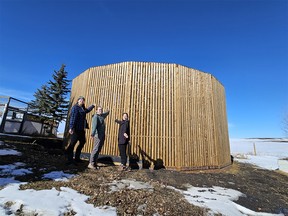Article content
Employees at a wildlife rehabilitation clinic north of Calgary say their new enclosure will help wild birds better recover from injury.
The Alberta Institute for Wildlife Conservation (AIWC) in north Rocky View County recently completed construction of a new 2,650-square-foot bird enclosure. Dubbed ‘the Runway,’ the space can accommodate a greater number of birds than its two previous enclosures, according to staff.
Article content
The enclosure is customizable, with features like adjustable perches, shelters and doors between pens. AIWC’s communications coordinator, Scottie Potter, said the space’s design will allow the animal hospital’s veterinarians to more accurately assess birds as they resume flying upon recovery from their injuries.
While the wildlife clinic has two similar enclosures, Potter said neither of those contain curved corners, which help staff better evaluate a rehabilitating bird’s turning and hunting skills.
“We have a perfect right-angled one, but that’s not quite what we needed, so this project was implemented to replace the old enclosures as well as develop something new and that met more of our rehabilitation needs,” she said.
“It’s all about making sure our ability to assess the birds is as accurate as possible.”

The Runway has already been tested by two great horned owls that are being treated for wing and eye injuries.
Other bird species that will benefit from the enclosure include juvenile hawks, eagles and ravens.
“One of the first birds that will be testing this site is a bald eagle that we just got into our care a couple of weeks ago,” Potter said. “She’s not quite ready yet to do a full flight pen testing, but she will likely be in there (soon) for our team to assess her flight.”
Article content
Majority of bird injuries result from interactions with humans
Based near the hamlet of Madden, about 40 kilometres northwest of Calgary, AIWC has been rescuing, rehabilitating and releasing orphaned and injured wildlife from throughout southern Alberta for 31 years. According to its website, the clinic has admitted more than 36,000 animals into its care since opening in 1993.
Birds make up a significant portion of those numbers, Potter said. The non-profit clinic treats upwards of 1,000 injured birds annually, with more than 1,400 arriving at the facility last year.
The clinic’s busiest time of year is in May or June, after the annual “baby boom” spike each spring, when many wildlife species give birth or hatch their young.
The majority of bird injuries result from interactions with humans, the most common cause being vehicular collisions.
To help reduce the number of injured or orphaned birds, AIWC recently released a video — the second episode of its Alberta Wildlife Insider series — with information on how to lessen the chance of inadvertently harming wild birds, specifically great horned owls.
“When it comes to specific things, one of the most important things would be driving safely — that’s one of the biggest threats to great horned owls,” Potter said.
Another human-caused hazard for wild birds is getting caught in barbed wire fencing, she added.
Those who come across injured or orphaned wildlife are encouraged to call AIWC’s wildlife hotline at 403-946-2361.
Share this article in your social network



